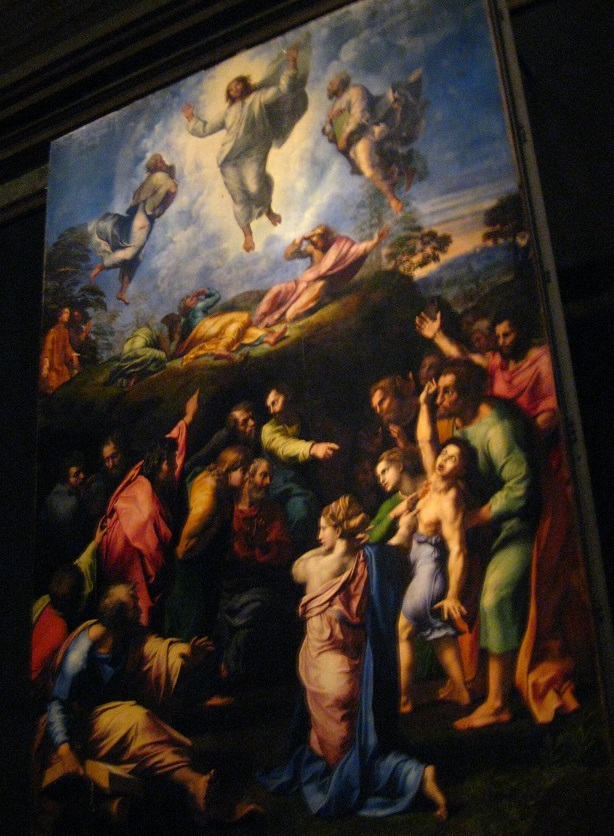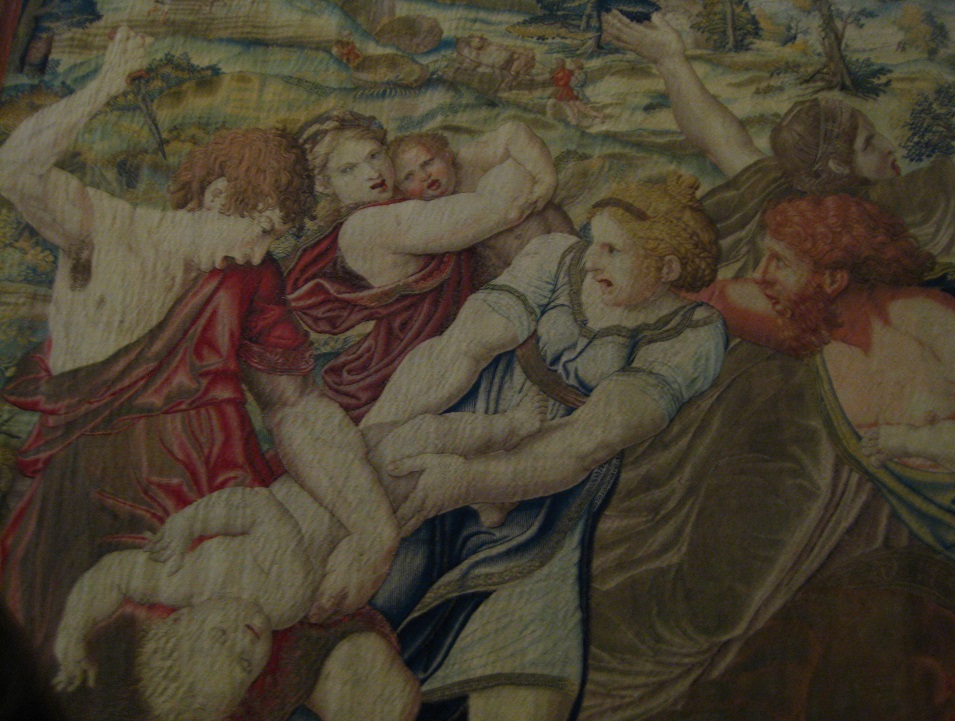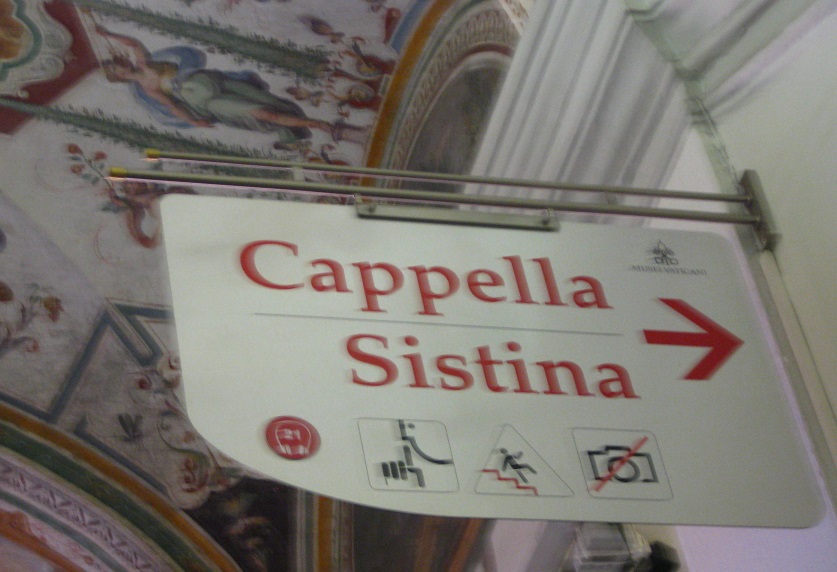 Perhaps you imagined the Vatican as I did, like a giant church with many chapels and relics. I thought there might even be cardinals wandering about, conducting the work of the church, and that I could wander part of it, oohing and ahhing over the grandeur of these places of prayer. In reality, the Vatican (excluding St. Peter’s Basilica) is more like a giant, guided museum. It’s a museum with a very precise order: no skipping to the rooms which interest you – due to the sheer number of tourists making their way through. So, you get your map and your audio guide and off you go into the maze.
Perhaps you imagined the Vatican as I did, like a giant church with many chapels and relics. I thought there might even be cardinals wandering about, conducting the work of the church, and that I could wander part of it, oohing and ahhing over the grandeur of these places of prayer. In reality, the Vatican (excluding St. Peter’s Basilica) is more like a giant, guided museum. It’s a museum with a very precise order: no skipping to the rooms which interest you – due to the sheer number of tourists making their way through. So, you get your map and your audio guide and off you go into the maze.
Before we embarked on the primary museum path, we toured the Picture Gallery (Pinacoteca). This featured quite a bit of art from the 1400s-1600s, including some well-known pieces. Unfortunately, this is not my favorite art era, so I struggled through. Of most interest to me were some of the works by a naturalist painter, who depicted animals in very real proportions and detail. Raphael’s Transfiguration, Da Vinci’s unfinished St. Jerome work, and Caravaggio’s Entombment of Christ are three of the ‘stars’ though.  After making our way through here, we had a tea in the courtyard and began our quest.
After making our way through here, we had a tea in the courtyard and began our quest.
First on the Museum Path, there was a large courtyard with a giant pine cone, a big Roman king head, and a globe sculpture similar to one I saw in Dublin a long time ago. This was the most personal space we were to have all day. Nothing exciting here, though I was amused that this area had one of the only signs in Russian in the whole place: it said to keep off the lawn.  This must be a common Russian transgression!
This must be a common Russian transgression!
Next, we walked through corridors featuring tablets of ancient writing, busts and statues of various myths and gods, and colorful mosaic floors. I was a bit surprised by the inclusion of cultural icons that the church doesn’t consider dieties. The art quality was good, though it was hard to see more  than one or two pieces in any room because of the crowd pressing you onward. My favorites were probably the scary faces decorating the ceiling of one of the courtyards. The rooms were really museum-quality though, from the intricate moldings and detailed frescoes to the gilding around busts of the popes. And that was besides the art that was on display in those rooms.
than one or two pieces in any room because of the crowd pressing you onward. My favorites were probably the scary faces decorating the ceiling of one of the courtyards. The rooms were really museum-quality though, from the intricate moldings and detailed frescoes to the gilding around busts of the popes. And that was besides the art that was on display in those rooms.
After the statues came a tapestry room, including a very evocative and violent ‘Rape of the Innocents’ tapestry. Several of these works came from the masters in Belgium who made the famous Normandy tapestries, etc.
Then, there was the map room: it had wall-length representations of each ‘kingdom’ of Italy – before unification and modern-day (for some). To me, the maps seemed a bit whimsical, showing the waves and the exploring ships, as much as the land masses.
A fter that were rooms of wall frescoes, including those done by Raphael and other great artists. The colors were incredibly vibrant, and it was hard not to be a bit undone by works like the one of Judith holding the cut-off head of Holofernes. Here, I felt like I could have sat in each room for hours, continually noticing new details included in these works. The flowing crowd was particularly annoying, as was my increasing fatigue.
fter that were rooms of wall frescoes, including those done by Raphael and other great artists. The colors were incredibly vibrant, and it was hard not to be a bit undone by works like the one of Judith holding the cut-off head of Holofernes. Here, I felt like I could have sat in each room for hours, continually noticing new details included in these works. The flowing crowd was particularly annoying, as was my increasing fatigue.
 Then, we went into the modern art section of the Vatican Museum, and that became my favorite. It was interesting to see Jesus depicted in Van Gogh’s familiar style, or papal robes done by Matisse. There were also works acquired by the church that didn’t seem to have any religious themes, from a copy of Rodin’s Thinker to a Dali work – and more by artists I wasn’t already familiar with. There was even a work by Chagall and another work showing Jews sitting around a table. This was the only uncrowded section of the museum, which was great for us, but sad for the under-appreciated works. I know that it was later into the museum, and people were getting increasingly antsy to see the Sistine Chapel, but I found this more interesting than the entire Picture Gallery (Pinacoteca) and beginning statue rooms put together.
Then, we went into the modern art section of the Vatican Museum, and that became my favorite. It was interesting to see Jesus depicted in Van Gogh’s familiar style, or papal robes done by Matisse. There were also works acquired by the church that didn’t seem to have any religious themes, from a copy of Rodin’s Thinker to a Dali work – and more by artists I wasn’t already familiar with. There was even a work by Chagall and another work showing Jews sitting around a table. This was the only uncrowded section of the museum, which was great for us, but sad for the under-appreciated works. I know that it was later into the museum, and people were getting increasingly antsy to see the Sistine Chapel, but I found this more interesting than the entire Picture Gallery (Pinacoteca) and beginning statue rooms put together.
Finally, the streaming crowd ushered us into the Sistine Chapel. Photos were forbidden, though others still took plenty of them. The disrespectful behavior I observed throughout Italy continued, with women dressed in clothing so insignificant, I wouldn’t wear it to sunbathe. (My favorite though wasn’t a woman: it was a 20-something guy touring the Vatican in a t-shirt with explicit swear words on it. I get that you’re a rebel, buddy, but people are letting you into a place they revere, and you’re giving them the middle finger. This type of attitude makes me hope that karma is real.)
 The space itself is indeed grand and awe-inspiring, but it was not what I expected. For one, the walls and the (Michaelangelo) ceiling were wholly mismatched! The ceiling figures were corpulent and rich, while the walls featured smaller-sized figures on a very different theme and in a different color scheme. Though all the hype is for the ceiling, I think that ignoring the artistry on the walls is a disservice to the space. I had some trouble following the progression of the depicted scenes: they seem to be more based on the artistic notion of symmetry than on the historic notion of chronology.
The space itself is indeed grand and awe-inspiring, but it was not what I expected. For one, the walls and the (Michaelangelo) ceiling were wholly mismatched! The ceiling figures were corpulent and rich, while the walls featured smaller-sized figures on a very different theme and in a different color scheme. Though all the hype is for the ceiling, I think that ignoring the artistry on the walls is a disservice to the space. I had some trouble following the progression of the depicted scenes: they seem to be more based on the artistic notion of symmetry than on the historic notion of chronology.
Also notable are the dimensions of the room itself. Not only is it very long, but there is a screen three quarters of the way through, essentially separating the room into two sections. Along the perimeter of the room are benches, on which tourists sit; I wonder if the middle is filled with folding chairs or rolling pews when the cardinals convene here for Pope selection.
Once an hour, a clergyman came in to say a prayer in the chapel, which was – to my mind – the only indication of the space’s purpose. The prayer was in English, and it started with a thank you to a group from Denmark, I believe. Sacrilegious though it may be, it reminded me of a quote I once read (and can’t seem to locate) to the effect of, “All religion is an advertisement, but I can’t seem to figure out if G-d is the product or the sponsor.”
Overall, a worthwhile visit if you like art or history at all, though you will feel like herded cattle. Schedule in advance, or you’ll stand in a ridiculously long line and/or pay significantly more. (With our pre-purchased tickets, we walked right in and got in.)
And yes, I know I left out St. Peter’s Basilica. We saw the outside in both the day and nighttime, but we didn’t actually go inside! We should have gone earlier in the visit, but after the number of churches we saw, we were a bit churched out. Something for next time, I suppose.